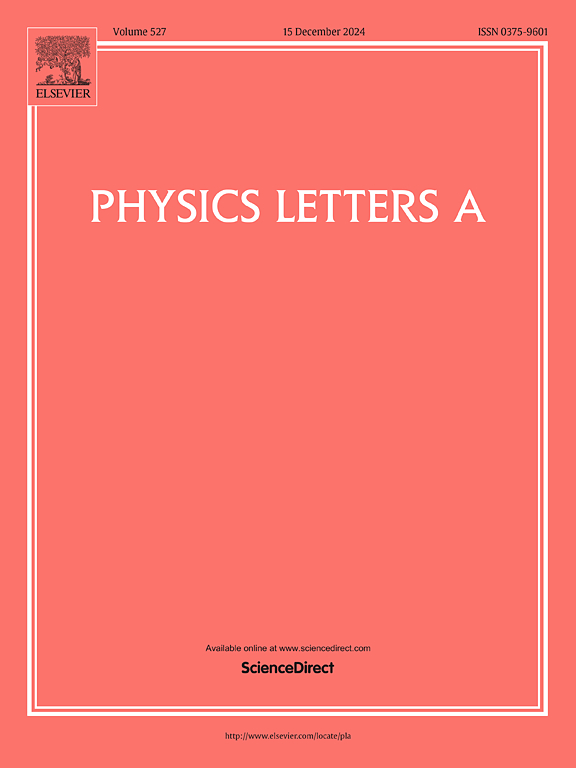Structural, stability and electronic properties of A7 SbAs rhombohedral phase under pressure variations
IF 2.3
3区 物理与天体物理
Q2 PHYSICS, MULTIDISCIPLINARY
引用次数: 0
Abstract
Antimony arsenide (SbAs), a bulk 3D binary compound has attracted significant interest since its experimental discovery in 2013. This is due to its potential applications in fields such as electronics, topological insulators, optoelectronics, thermoelectrics, and piezoelectrics. In the A7 rhombohedral phase, SbAs manifests a pseudo-layered structure with interlayer interactions mediated by weak van der Waals forces. In the present work, we have employed first-principles calculations to investigate the pressure-dependent structural, stability, and electronic properties of SbAs in the A7 phase. Our results indicate that the lattice parameter along the a-axis shows a continuous reduction under pressure, whereas, the c-axis evolves with anisotropic compression. Bond lengths and bond angles decrease systematically with a linear trend emerging above 60 GPa like the lattice parameters. Symmetry analysis shows a pressure-induced phase transition from the non-centrosymmetric space group R3m to the centrosymmetric Rm. Phonon dispersion relations show a lack of imaginary modes at ambient pressure, but the onset of instability is observed between 20 and 40 GPa, with the appearance of imaginary modes that decrease in intensity from the former to the latter stated pressure point. However, these modes dissipate from around 60 GPa and above signifying the material's dynamic stability at high pressures. On the electronic front, SbAs exhibits a transition from a semimetallic to a metallic state with increasing pressure accompanied by a rise in the Fermi energy. Furthermore, spin-orbit coupling (SOC) has also been observed to play a significant role in the material's electronic characteristics.
压力变化下A7 SbAs菱面体相的结构、稳定性和电子性能
砷化锑(SbAs)是一种大块三维二元化合物,自2013年被实验发现以来就引起了人们的极大兴趣。这是由于它在电子学、拓扑绝缘体、光电子学、热电学和压电学等领域的潜在应用。在A7菱面体相中,SbAs表现为伪层状结构,层间相互作用由弱范德华力介导。在目前的工作中,我们采用第一性原理计算来研究A7相sba的压力依赖结构、稳定性和电子性质。结果表明,在压力作用下,沿a轴的晶格参数呈连续减小趋势,而沿c轴的晶格参数则随各向异性压缩而变化。键长和键角与晶格参数一样,在60 GPa以上呈线性下降趋势。对称性分析表明,从非中心对称空间群R3m到中心对称空间群R3 - m存在压力诱导的相变。声子色散关系显示在环境压力下缺乏虚模,但在20 ~ 40 GPa之间观察到不稳定的开始,并且出现了虚模,从前者到后者规定的压力点强度降低。然而,这些模式在大约60gpa及以上时消散,这表明材料在高压下的动态稳定性。在电子前沿,随着压力的增加,SbAs呈现出从半金属态到金属态的转变,并伴随着费米能量的上升。此外,自旋轨道耦合(SOC)也被观察到在材料的电子特性中起着重要的作用。
本文章由计算机程序翻译,如有差异,请以英文原文为准。
求助全文
约1分钟内获得全文
求助全文
来源期刊

Physics Letters A
物理-物理:综合
CiteScore
5.10
自引率
3.80%
发文量
493
审稿时长
30 days
期刊介绍:
Physics Letters A offers an exciting publication outlet for novel and frontier physics. It encourages the submission of new research on: condensed matter physics, theoretical physics, nonlinear science, statistical physics, mathematical and computational physics, general and cross-disciplinary physics (including foundations), atomic, molecular and cluster physics, plasma and fluid physics, optical physics, biological physics and nanoscience. No articles on High Energy and Nuclear Physics are published in Physics Letters A. The journal''s high standard and wide dissemination ensures a broad readership amongst the physics community. Rapid publication times and flexible length restrictions give Physics Letters A the edge over other journals in the field.
 求助内容:
求助内容: 应助结果提醒方式:
应助结果提醒方式:


